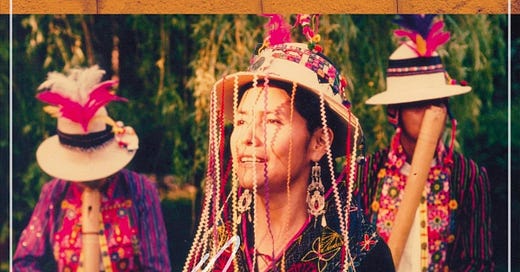EVERY GENRE PROJECT - April 7 - Harawi
Genre of the Day - Harawi
Album of the Day - Arawi: The Spirit of the Andes by Luzmila Carpio (1998)
April 8, 2024
There may be actual birds possessing some Andean singers. When I covered exotica, we listened to an Yma Sumac album, perhaps the queen of birdsong-like, inhuman vocal gymnastics. On today’s album, Luzmila Carpio demonstrates the same phenomenon. Perhaps it’s simply nurture and a cultural facet of singing from these areas, or maybe it’s nature and genetically women might have higher average tessituras (comfortable singing range) allowing them to soar into the upper octaves like riding the breeze. Either way, the majesty of the Andean condor flying above the mountains permeates into this music vocally.
Harawi is a very old genre that survives to this day, and traces itself all the way back to the woefully short-lived Inca Empire. I’ve been reading a book about the last days of the Inca Empire, so there’s a lot that I could say, but we’ll keep it mostly to music. Harawi spread with the massive overtaking of the region by the Incas, who only made up 2% of the region’s population ethnically, but were so sophisticated in military might and road building that they were effectively able to steamroll all the regional competition. Under a common ruler, shared musical traditions were able to flourish in what was the largest empire that ever existed in the Americas.
The Quechua word harawiq translates roughly as poet in English, encapsulating the genre’s essence as sung poetic verses over the quena, a traditional Andean flute. It’s a female-led genre, with female vocalists weaving tales of melancholy, death, and appreciation for nature. Many songs feature veneration for Pachmama, the earth goddess who’s essential in Inca cosmology. Given this essentiality to traditional indigenous culture, those damn meddling Spaniards led to the genre gradually becoming less prominent in indigenous communities. However, fortunately people have carried it on over the centuries and singers like Luzmila Carpio have pushed its importance on a global scale.
Over delicate guitar, charango (a small post-colonial Andean lute), and quena instrumentation, Carpio’s voice sails and revels. Her voice is incredibly distinctive: high-pitched, bright, and sweetly childlike in its lilt, it carries a unique joy. The tones she reaches are insane: on the title track “Arawi” the stunning fluidity of her ability to replicate the flute and duet with the instrument particularly stands out. However, it’s not all about a vocal showcase: while I’d be hard-pressed to understand the Quechua lyrics, the occasional lapses into Spanish such as the speech on “Pachamamata Tikanchasun” drive home the message of environmental preservation and engaging in acts that respect Pachamama. There’s also a richness of emotional shades across the album, ranging from sunnier ditties to more dissonant flute-led songs and the dramatic drumming of “Tunupan Samiripa.” Carpio’s voice and lyrics don’t just make her an incredible artist: she served as Bolivia’s ambassador to France. I would love to see more recognition of indigenous artists as cultural and environmental ambassadors in that same vein: the music speaks for itself.




